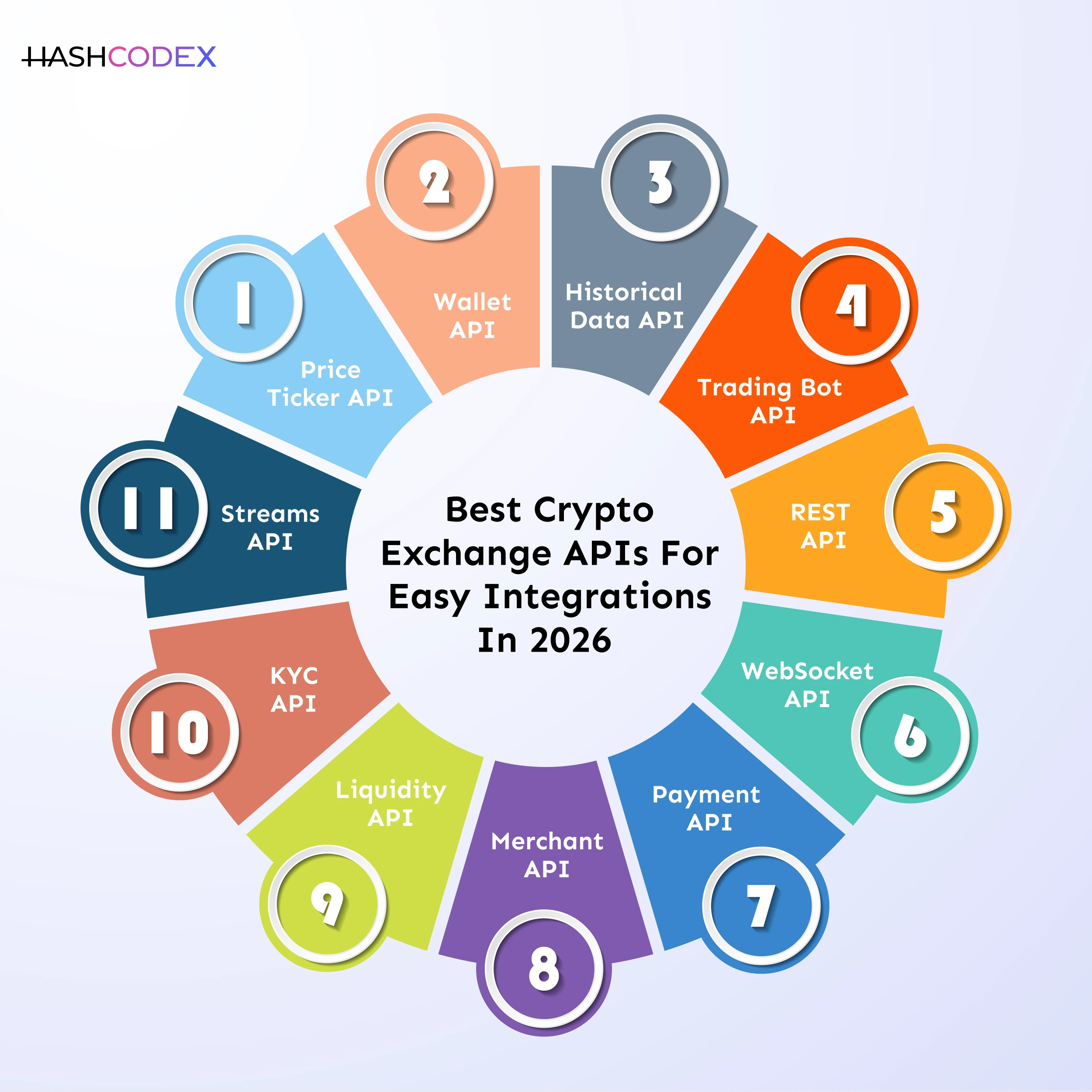Just building a crypto exchange? That’s not enough.
You might be thinking, “If I launch an exchange and get some traders, I’ll be successful.”
But let’s be real. That’s not how things work anymore.
Today, everyone is launching a crypto platform. So how will yours stand out?
To make your exchange truly powerful, you need the right mix of tech tools. Not just the basics. You need the smart stuff that makes everything better.
Like what?
- A secure payment gateway
- A strong crypto wallet
- Real-time price tracking
Like these things decide how fast, safe, and user-friendly your exchange feels.
Now here’s the part most people miss.
Behind all these features, something is working quietly in the background.
That is APIs.
Yes, APIs are the real heroes. They connect everything like prices, wallets, payments, and charts. That’s what makes your exchange run like butter.
Every developer and founder who is serious about building a crypto exchange knows this truth.
So if you are planning to launch your own exchange in 2026 or are already running one, you must focus on the right API integrations.
In this post, we will show you the top crypto exchange APIs to use in 2026.
What is a Crypto Exchange API?
Let’s keep it simple.
API means Application Programming Interface. You can think of it like a middleman between your crypto exchange and other systems.
Suppose you want to order food at a restaurant. You tell the waiter what you want. He goes to the kitchen, gets the order ready, and then brings it back to you. That's how APIs work. They take requests, collect data, and send it back to you.
In a crypto exchange, APIs do thousands of small jobs every second. They show coin prices, manage trades, send wallet details, and much more.
Types of Crypto Exchange APIs You Should Know About
Every crypto exchange and many other platforms use APIs. But not all APIs do the same job. Each one has its own role and purpose. Let’s look at the common types of APIs used in crypto exchanges.

1. Public APIs
These are open to everyone. They show general market data like coin prices, trading volume, and recent price changes.
Even if someone is not logged in, they can still see basic details. This information comes from public APIs.
It is like showing prices and updates on a digital board. Anyone can walk by and read it. These APIs help users get a quick idea of what is happening in the market without needing an account.
2. Private APIs
These are only for people who have an account on the exchange.
Private APIs help users do personal actions like placing buy or sell orders, checking wallet balance, or seeing trade history.
It works like a personal control panel. Each trader uses it to manage their own account and data. These APIs need secure login and permission because they deal with sensitive user information.
3. Partner APIs
These help your exchange connect with other services and companies.
For example, if you work with a liquidity provider or a payment system, they give you access through partner APIs.
It is like building a bridge between your exchange and another platform. Both sides can share data safely. This helps your users get more features like faster payments or better trading options.
4. Composite APIs
Sometimes, you do not want to send many requests for different tasks.
Composite APIs combine many requests into one. So instead of asking separately for wallet info, live prices, and open orders, you get everything together in one response.
This saves time and reduces the load on your system. It also makes the user experience better because they get all the important data at once.
5. Internal APIs
These are not for public use. They work inside the system and are used by the backend team.
Internal APIs help different parts of your exchange talk to each other. For example, your KYC dashboard, admin panel, and analytics tools use these APIs to share data.
They are the hidden part of your exchange. Users do not see them, but they are very important to keep everything working properly and safely.
Best Crypto Exchange APIs for Easy Integrations in 2026
Your platform needs smart tools called APIs. These APIs help your exchange work faster, safer, and more reliably. Let’s look at the important ones one by one.

1. Price Ticker API
This API collects the latest prices of coins like Bitcoin, Ethereum, and others from different exchanges. It updates your platform with real-time prices.
For example, if a user wants to check the price of Bitcoin or any other coin, they should see the current rate. Without this API, the price shown might be old or delayed. With it, users get fresh and correct price details every second.
2. Wallet API
This API helps manage users' crypto balances. It stores and updates the wallet information safely.
For example, if a user deposits 0.5 BTC, their balance will update immediately. Later, if they withdraw 0.1 BTC, it will reflect correctly.
No need for manual checking or delay. Everything happens automatically and securely.
3. Historical Data API
Traders do not make decisions only by looking at yesterday’s prices. They often check past data from weeks, months, or even years.
This API gives the full history of coin prices from the time the coin was launched.
It helps traders study long-term trends, compare past performance, and make smarter trading decisions.
4. Trading Bot API
Many experienced traders use bots to trade automatically. They set rules and let the bot do the work based on market conditions.
For example, a bot can be set to buy Bitcoin if the price drops by 5 percent. The API will follow the rule and complete the trade without any human help. This saves time and helps traders stay active even when they are busy.
5. REST API
This API acts like a bridge between your platform and the server. It helps send and receive data based on user actions.
It works using commands like GET, POST, PUT, PATCH, and DELETE. These commands help users check their balance, place trades, update details, or cancel orders.
Every button the user clicks uses the REST API in the background to make things happen.
6. WebSocket API
WebSocket API is slightly different from REST API. REST API asks for data again and again. But WebSocket keeps the connection open and sends updates automatically.
When WebSocket is added, a handshake happens between the server and the platform. This allows users to see live changes on the website without refreshing.
It is like watching live cricket scores where updates come instantly.
7. Payment API
To connect wallets and exchanges, you need a Payment API. It helps users send and receive crypto or convert it to regular money.
Fast payments make your exchange more trusted. Users feel happy when there are no delays in deposits or withdrawals.
Also, it makes converting crypto to fiat currency easy.
8. Merchant API
If your exchange wants to support businesses or allow crypto payments, this API is very useful.
Merchant API helps businesses do things like:
- Convert crypto to local currency
- Check if payments are real
- Keep transactions safe and verified
This makes your platform useful not just for traders but also for shops, service providers, and online businesses.
9. Liquidity API
If your exchange has low liquidity, trades will be slow, and prices may not be good for users.
Liquidity API connects your platform with other exchanges or liquidity pools. This way, users get better prices and trades happen faster.
Even though everything looks like it’s happening on your own website, the backend connects with other sources to improve the trading experience.
10. KYC API
To run a legal and trusted exchange, you must follow rules and verify users properly.
KYC API helps check the identity of users who sign up. It verifies their ID and activates their account only after proper checks. This keeps your exchange safe from fake accounts and scams.
Users feel secure knowing that the platform is serious about safety.
11. Streams API
Streams API sends live data from the server to your exchange. But unlike the WebSocket API, it only works in one direction.
Your platform can receive data, but it cannot send anything back through this API. It is useful for showing live updates like price movements, trade history, and order book changes.
The Streams API is best for dashboards and charts where you just want to display live information. It helps users stay updated without clicking or refreshing the page.
How to Choose the Right Crypto Exchange API for Your Business
Picking the right API is a big step when building your crypto exchange. It can make your platform faster, safer, and easier to manage. Here’s how you can choose smartly:
1. Know your goals
First, be clear about what your exchange is meant to do. Are you focusing on trading, handling payments, or supporting merchants? Once you know your goal, it becomes easier to pick the right APIs.
2. Check the API documentation
Always choose APIs that have clear and updated documentation. It should explain how to use the API step by step. This will save your developers a lot of time and avoid confusion during setup.
3. Test the speed
A good API should respond quickly. If it takes too long, users may face delays while trading or checking prices. Always test how fast the API works before using it fully.
4. Focus on security
Make sure the API uses strong security methods like encryption and proper login checks. This helps protect your users’ data and keeps your platform safe from hackers.
5. Think about scalability
Your exchange may start small, but it can grow fast. Choose APIs that can handle more users and more traffic in the future without slowing down.
6. Look for support and updates
Go with API providers who offer good technical support and regular updates. If something goes wrong or if you need help, their support team should be ready to assist.
New plans. New projects. New results. Or just another scroll
session. You choose the story.
Top Benefits of Using Trusted Crypto Exchange APIs
By choosing the correct crypto exchange APIs for integration, entrepreneurs and business people who have an exchange or are planning to build one will get better benefits.
- Faster Development
- Real-Time Market Data
- Improved Security
- Better User Experience
- Multiple Integrations
- Scalability for Growth
- Cost Efficiency
- Automated Processes
- Enhanced Reliability
- Faster Time to Market
Final Thoughts
I hope you now understand why APIs are important and how they help both entrepreneurs and traders.
If we want to compete with the best exchanges, adding the right APIs is the smart move.
From faster trades to better liquidity and global payments, everything depends on how well your exchange uses APIs.
In the coming years, we will see more advanced APIs with features like artificial intelligence, cross-chain support, and auto-trading tools.
For startups and business owners, this is the right time to build with a strong base. APIs are not just extra tools. They are the main system that keeps your exchange active day and night.
And if you are planning to build or upgrade your exchange, Hashcodex is a trusted crypto exchange development company. We offer complete services with all the important APIs and advanced integrations to match your business needs.











